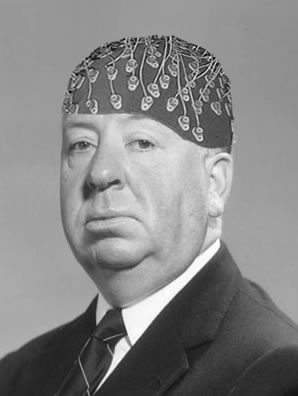Alfred Hitchcock, Your Brain, and DARPA
 Why were Alfred Hitchcock films so riveting? The legendary director didn’t have access to brain scans, but it’s clear he knew how to hold the attention of the audience, create tension, and occasionally make the audience jump. The concept of neurocinema – using neuromarketing tools to measure viewer reaction to films – isn’t new (see Movie Mind Control), but it’s getting the academic treatment with new research from City College of New York and Columbia University. The researchers measured the brain activity of subjects as they viewed a variety of film segments. And, in an odd twist, the research is funded by DARPA – the Defense Advanced Research Program Agency.
Why were Alfred Hitchcock films so riveting? The legendary director didn’t have access to brain scans, but it’s clear he knew how to hold the attention of the audience, create tension, and occasionally make the audience jump. The concept of neurocinema – using neuromarketing tools to measure viewer reaction to films – isn’t new (see Movie Mind Control), but it’s getting the academic treatment with new research from City College of New York and Columbia University. The researchers measured the brain activity of subjects as they viewed a variety of film segments. And, in an odd twist, the research is funded by DARPA – the Defense Advanced Research Program Agency.
The researchers showed subjects wearing EEG caps Alfred Hitchcock’s “Bang! You’re Dead” and Sergio Leone’s “The Good, the Bad and the Ugly,” both movies with tense moments. A film of random campus scenes was used as a control. They found that three kinds of scenes produced the highest levels of activation:
- Powerful visual cues, like a close-up on a gun
- Ominous music, even when the screen action wasn’t significant (see my earlier post, Close Your Eyes, Change Your Brain)
- Meaningful scene changes
Here’s a video that shows how the EEG activity correlates with scenes in the Hitchcock film (it’s a bit long and there’s no explanation of what you are seeing, so feel free to skip around):
Story is Important
Neuromarketing readers won’t be surprised that the researchers found that a coherent narrative maximized viewer engagement. When scenes were shown out of sequence, the EEG data showed lower levels of activity.
Why Does DARPA Care?
Film appreciation seems like an unlikely area of interest for DARPA, a government agency known for developing ultra-advanced weapons technology. The key, perhaps, is DARPA’s interest in the power of stories. As I described in a post at Copyblogger, How to Write Weapons-Grade Copy, DARPA understands that narratives have a unique ability to hold our attention and engage our brains in a variety of ways.
We know that films can keep us rooted to our theater seats for hours. We know that they can scare the heck out of us, make us cry, or fill us with warm, happy feelings. Can they be turned into offensive or defensive weapons? Maybe DARPA thinks so. As a tool for persuasion (or propaganda), stories are powerful. (At the moment, this explanation of DARPA’s interest in Alfred Hitchcock and Clint Eastwood is my own speculation – if I can find out more, I’ll let you know!)
Of course, the ultimate film weapon might be U.S. reality television and sitcoms. Based on the effects I described in Why Jersey Shore Drops the National IQ, perhaps DARPA should subsidize this content for viewing in any nation deemed to be a threat! 😉

Great articlr once again 🙂